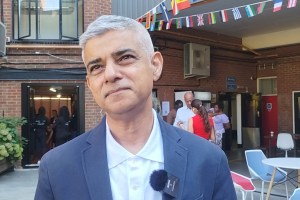Two areas of Outer London have been picked out as examples of how to make walking and cycling more enjoyable in the city, as Transport for London (TfL) is being told to make streets wider and less cluttered.
By Kumail Jaffer, Local Democracy Reporter

Two areas of Outer London have been picked out as examples of how to make walking and cycling more enjoyable in the city, as Transport for London (TfL) is being told to make streets wider and less cluttered.
Last month the London Assembly Transport Committee heard from experts who suggested the capital’s road widths need to be narrowed to allow pedestrians more pavement space, to improve rates of walking. On Friday (October 3), members of the committee visited Ilford, in the Redbridge borough, as part of their investigation into practical steps that can be taken to make London a better city for walking.
Living Streets, the UK’s charity for everyday walking, joined the trip and its Director of External Affairs and Fundraising, Tanya Braun, was impressed with Ilford’s setup. She told the Local Democracy Reporting Service (LDRS): “In an hour’s walk in Ilford, we toured both the pedestrianised high street and the residential areas. We want to see wide pavements that don’t have lots of clutter on them – A Boards, dockless bikes, bins.
“It was good to see pedestrianised areas with clear paving that isn’t cracked and broken that pose a serious problem for vulnerable or less sturdy adults. The high street was smooth, clear and had lots of space – there wasn’t many things that got in the way.
“It also had interactive play equipment with children on it, and trees lining the street, which improves air quality and adds attractiveness to the area. The accessibility was also quite good – there’s a lot of opportunities to catch public transport from multiple points on the high street.”
She also picked out neighbouring Waltham Forest as a borough that had prioritised cycling infrastructure, suggesting other outer boroughs could take a leaf out of its book. Ms Braun said their extensive cycling connectivity and 20mph limits have made a “major difference” to how people approach transport.
Walking in London has stagnated
When it comes to walking, TfL had set a target to increase the number of journeys by foot from 6.4million in 2018 to 7.5million in 2024. However, the latest official figures show that the number has not increased since peaking at 6.7million in 2019, despite the number of car journeys falling.
The Transport Committee’s Chair, Elly Baker, told the LDRS: “TfL have a walking action plan from 2018 but the numbers have stagnated for years. What we wanted to do is look at one aspect of this – pavements.
“The experience of pavements resonates with everyone in their daily lives but isn’t talked about that much. If people are going to want to walk, then they will have to be pleasant, well-maintained and have facilities to sit down and rest.
“We have to think about what the experience for people is when getting around on foot. There are many inter-connected reasons as to why more people aren’t walking – but the overall picture is that if it’s nicer to walk about and people feel comfortable, they’re more likely to make those little trips by foot.”
While Ms Braun was impressed in general with Ilford, she said there is room for improvement, noting: “The underpasses varied in quality – the ones you could clearly see through to the end were better, but there were some where that wasn’t possible and that had an uninviting feel. Overall, the walkability of the pavements were really good.
“We don’t see that across the whole of London – certainly with those in our communities who find it harder to get out full stop, that can put them off further. It’s a key step to reducing social isolation and car journeys, especially in the outer boroughs.
“It’s so important that there is at least 1.5metres space on the pavement – there are simple steps that other London boroughs can make, such as reducing clutter and prioritising pavements for repair when needed. If TfL want to increase the number of people walking, then the pavements need to be fixed. There are many more that could be improved.”
Conflicting views on pedestrianisation
Pedestrianisation of high streets and large swathes of areas has been a contested topic in recent years.
Ms Braun suggested many business owners mistakenly feel that making areas more pedestrian-friendly would reduce footfall as car parking spaces are taken away. Any loss from those driving could be made up by people choosing to walk in a more pleasant environment, she suggested.
“More walkable areas boost business – there’s often a misconception with business owners that most of their customers drive to their shops, but a significant proportion definitely walk. The outer boroughs need better connectivity – in Ilford, we did see lots of buses and the Elizabeth Line – but it takes too long to get around the outer boroughs, much longer than it does by car.
“The inner and central boroughs are much more walkable because there are so many public transport options. The amount of people in London who do walking journeys is significantly higher than the rest of the country – the appetite is there. But structural barriers put them off, as does time and distance.”
She was speaking on the same day that the Mayor’s office said footfall on Oxford Street was 45 per cent higher during a one-day pedestrianisation trial than the week before.
Last month London’s Walking and Cycling Commissioner, Dr Will Norman, said the stagnation of daily walking trips was also down to a “wider societal” trend of people not going out as much since the pandemic.
He told the London Assembly Transport Committee: “The recovery has been slower than all of us would have desired. Hybrid working and economic challenges [are] meaning people are feeling the squeeze and taking fewer leisure trips. This has been reflected in every mode of transport.”
TfL was approached for comment.









